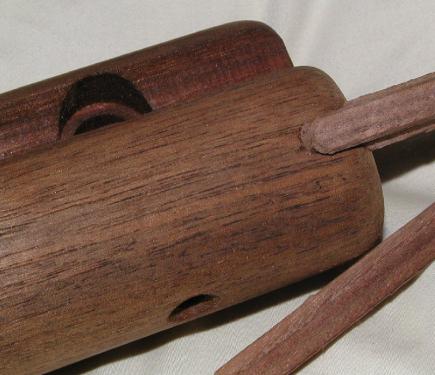Well I guess it's all over except for the crying now.

On my first attempt at the filler piece, I found what looked like a good section of grain to use and started cutting the side angles. Measured carefully and got a good tight fit to the dovetail.
Then I noticed my mistake. The nice section of grain I chose wound up on the
bottom of the filler piece. Of course when I flipped it over the grain on the top was running 25° off in another direction from the stock.

Wetting both pieces per Larry showed the filler piece was lighter in color anyway.
So on the next try I chose a darker section of the walnut Tom had sent, and made sure to get the grain I wanted facing in the right direction this time. I cut the angles on the second filler piece, and tested it for fit. Wet down the wood again and it looks pretty good to me. (But what do I know?)
Then I had to sand down one end of the filler piece to match the 60° angle of the dovetail and it's 3/32" radius. So I set the table of my belt sander to 60° and started sanding the radius into the end. After that I opened up my bottle of white glue and spread a thin coat on both pieces. Tapped the filler piece into the dovetail with a small hammer until it stopped, and the excess glue was forced out around the edges.
I wiped off the excess with a wet rag and then saw what I was dreading all along. A thin glue line around the radius of the filler on the outside of the stock. Apparently I must have lifted the piece off of the belt sander table a bit when I was doing the radius and ended up with 58° instead of 60° because there is the slightest gap at the top.

I'll just have to see what I can do with it when it comes time to blend the two pieces together.









![[Image: TomsTechLogo-Profile.png]](http://tomstechniques.com/wp-content/uploads/2013/11/TomsTechLogo-Profile.png)





